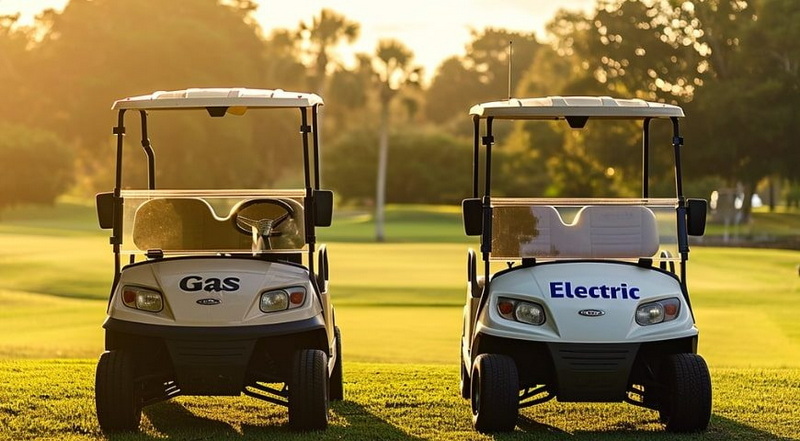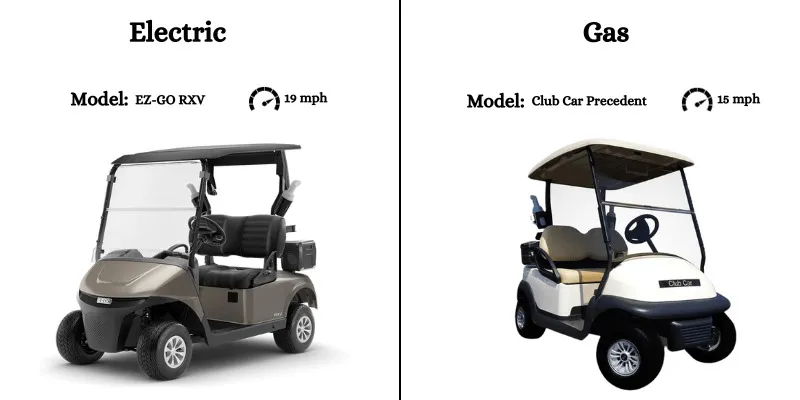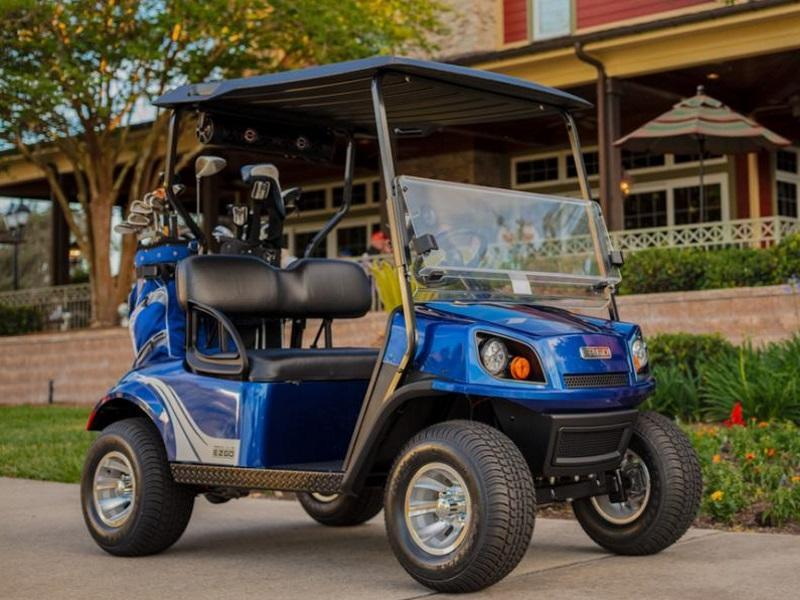Content Menu
● Speed Comparison Between Gas and Electric Golf Carts
● Acceleration and Torque
● Performance on Different Terrains
● Environmental Impact
● Cost Considerations
● Maintenance Requirements
● Ride Comfort and Experience
● Range Comparison
● Charging vs. Refueling Time
● Customization Options
● Safety Considerations
● Conclusion
● FAQ
>> 1. How fast can an electric golf cart go?
>> 2. What is the top speed of a gas golf cart?
>> 3. Which type of golf cart is better for hilly terrain?
>> 4. Are electric golf carts environmentally friendly?
>> 5. What are the maintenance differences between gas and electric golf carts?
When it comes to golf carts, two primary types dominate the market: gas and electric. Each type has its own advantages and disadvantages, especially regarding speed, performance, and usability. This article explores the speed differences between gas and electric golf carts, their performance characteristics, and other factors that may influence your choice.

Speed Comparison Between Gas and Electric Golf Carts
The speed of a golf cart is a crucial factor for many users. Generally, electric golf carts tend to have a higher top speed compared to their gas counterparts.
- Electric Golf Carts: Most electric golf carts can reach speeds of 20 to 25 miles per hour (mph) without modifications. For instance, models like the EZGO 2Five can achieve a top speed of 25 mph, making them one of the fastest options available in the market.
- Gas Golf Carts: Gas-powered golf carts typically reach speeds of 15 to 20 mph. Some high-performance models may push closer to 25 mph, but this is less common and often requires modifications.
In summary, while both types can be fast, electric golf carts generally have the edge in terms of top speed.
Acceleration and Torque
Acceleration is another critical aspect where electric golf carts shine due to their design:
- Electric Golf Carts: They provide instant torque, allowing for rapid acceleration from a standstill. This characteristic makes them highly responsive on the course and ideal for quick starts.
- Gas Golf Carts: Although they have higher horsepower (typically around 10-15 HP compared to electric carts' 3-5 HP), gas carts usually take longer to reach their top speeds. They are better suited for sustained power over longer durations rather than quick bursts of speed.
Performance on Different Terrains
When considering performance on various terrains, the choice between gas and electric becomes more nuanced:
- Gas Golf Carts: They excel in hilly terrains and can handle rougher surfaces more effectively due to their higher horsepower. This makes them suitable for users who frequently navigate steep inclines or uneven ground.
- Electric Golf Carts: While they may struggle with very steep hills compared to gas models, they are still capable of handling moderate inclines thanks to their torque. Electric carts are quieter and provide a smoother ride overall.
Environmental Impact
One significant difference between gas and electric golf carts lies in their environmental impact:
- Electric Golf Carts: These are environmentally friendly as they produce zero emissions during operation. Their reliance on electricity makes them a cleaner option compared to gas-powered models.
- Gas Golf Carts: They emit carbon monoxide and other pollutants, contributing to air pollution. However, they are often favored for their longer range and quicker refueling times.

Cost Considerations
The cost of ownership can vary significantly between gas and electric golf carts:
- Electric Golf Carts: Generally have a lower initial purchase price but require battery replacements every few years, which can be costly. Additionally, charging costs are typically lower than gasoline prices over time.
- Gas Golf Carts: While they may have a higher upfront cost due to engine complexity, they do not require battery replacements. However, ongoing fuel costs can add up depending on usage.
Maintenance Requirements
Maintenance is another area where these two types differ:
- Electric Golf Carts: They require less maintenance due to fewer moving parts. Regular checks on battery water levels and occasional tire maintenance are usually sufficient.
- Gas Golf Carts: These require more frequent maintenance due to their engines. Oil changes, fuel system cleaning, and other mechanical checks are necessary to keep them running smoothly.
Ride Comfort and Experience
The comfort level of riding in a golf cart can significantly affect user experience:
- Electric Golf Carts: Tend to offer a quieter, smoother ride due to their silent operation. The absence of engine noise enhances the overall experience for passengers, making them ideal for use in quiet environments like residential areas or golf courses.
- Gas Golf Carts: While some users appreciate the traditional sound of a combustion engine, others may find it distracting or noisy. The ride can feel bumpier due to vibrations from the engine compared to the smoothness offered by electric models.
Range Comparison
Range is an essential consideration when choosing between gas and electric golf carts:
- Gas Golf Carts: Typically have a much longer range than electric models. A full tank can allow for travel distances of up to 100-200 miles, depending on the model and driving conditions.
- Electric Golf Carts: Usually have a range of about 25-50 miles on a single charge. This limitation means that users must plan charging times into their outings or risk running out of power mid-use.

Charging vs. Refueling Time
The time it takes to recharge or refuel is another important factor:
- Gas Golf Carts: Refueling is quick—similar to filling up a car at a gas station—taking only minutes before you're back on the road.
- Electric Golf Carts: Charging can take anywhere from 8 to 14 hours, depending on the charger used and battery capacity. This downtime can be inconvenient if you need immediate access after use.
Customization Options
Both types of golf carts offer customization options that can enhance performance:
- Electric Golf Carts: Many models allow for software upgrades that can increase speed or improve battery efficiency. Additionally, lithium-ion batteries provide better performance compared to traditional lead-acid batteries.
- Gas Golf Carts: These often have more extensive aftermarket support for modifications like upgraded engines or performance parts that can increase horsepower and speed significantly beyond stock configurations.
Safety Considerations
Safety should always be a priority when operating any vehicle:
- Both types come with safety features such as seat belts and headlights; however, users should familiarize themselves with local regulations regarding speed limits for golf carts in residential areas or public roads.
Conclusion
In conclusion, when comparing gas and electric golf carts in terms of speed, electric models generally offer higher top speeds and faster acceleration due to their instant torque capabilities. However, gas-powered carts provide greater power for hauling heavy loads and better performance on rugged terrains.
Ultimately, the choice between a gas or electric golf cart will depend on individual needs such as terrain type, desired speed, environmental considerations, maintenance preferences, range requirements, and budget constraints.

FAQ
1. How fast can an electric golf cart go?
Most electric golf carts can achieve speeds of 20 to 25 mph depending on the model.
2. What is the top speed of a gas golf cart?
Gas golf carts typically reach speeds of 15 to 20 mph but can go up to 25 mph with modifications.
3. Which type of golf cart is better for hilly terrain?
Gas golf carts are generally better suited for hilly terrains due to their higher horsepower.
4. Are electric golf carts environmentally friendly?
Yes, electric golf carts produce zero emissions during operation.
5. What are the maintenance differences between gas and electric golf carts?
Electric golf carts require less maintenance than gas models due to fewer moving parts; however, gas carts need regular engine checks and oil changes.











































